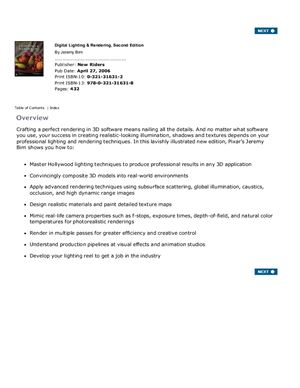Издательство New Riders, 2006, -406 pp.
To help you make better 3D renderings, this book fuses information from several fields. In these pages you will find concepts and techniques from professional cinematography, design principles from traditional visual arts, practical advice based on professional film production experience, and plain-English explanations of the latest science behind the scenes.
You should read this book when you have at least a working knowledge of how to use a 3D package, and are interested in taking your 3D rendering further.
For professional users of 3D rendering software, this book is designed to help with real-world production challenges and contribute to the ongoing growth of your work.
For students of computer graphics, this book will help you develop more professional rendering skills.
For dedicated 3D hobbyists, this book can help you improve the artistic quality of your 3D renderings and lea more about professional approaches to graphics production.
This book is written to be clear, but not condescending. Every effort has been made to define terms the first time they are used, and to illustrate every concept and technique with figures and sample renderings.
This book is designed to complement, rather than to replace, your software's manuals and help files. Most of the information you find here is not in your software's manual, even if some of it should be.
Fundamentals of Lighting Design
Lighting Basics and Good Practices
Shadows and Occlusion
Lighting Environments and Architecture
Lighting Creatures, Characters, and Animation
Cameras and Exposure
Composition and Staging
The Art and Science of Color
Shaders and Rendering Algorithms
Designing and Assigning Textures
Rendering Passes and Compositing
Production Pipelines and Professional Practices
To help you make better 3D renderings, this book fuses information from several fields. In these pages you will find concepts and techniques from professional cinematography, design principles from traditional visual arts, practical advice based on professional film production experience, and plain-English explanations of the latest science behind the scenes.
You should read this book when you have at least a working knowledge of how to use a 3D package, and are interested in taking your 3D rendering further.
For professional users of 3D rendering software, this book is designed to help with real-world production challenges and contribute to the ongoing growth of your work.
For students of computer graphics, this book will help you develop more professional rendering skills.
For dedicated 3D hobbyists, this book can help you improve the artistic quality of your 3D renderings and lea more about professional approaches to graphics production.
This book is written to be clear, but not condescending. Every effort has been made to define terms the first time they are used, and to illustrate every concept and technique with figures and sample renderings.
This book is designed to complement, rather than to replace, your software's manuals and help files. Most of the information you find here is not in your software's manual, even if some of it should be.
Fundamentals of Lighting Design
Lighting Basics and Good Practices
Shadows and Occlusion
Lighting Environments and Architecture
Lighting Creatures, Characters, and Animation
Cameras and Exposure
Composition and Staging
The Art and Science of Color
Shaders and Rendering Algorithms
Designing and Assigning Textures
Rendering Passes and Compositing
Production Pipelines and Professional Practices

